



|
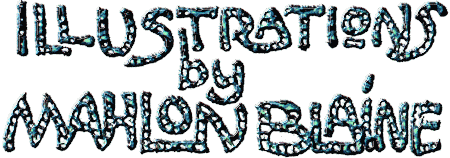
|
|
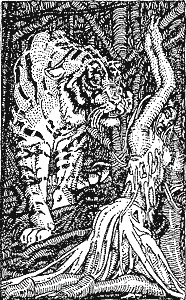 The enigmatic Mahlon Blaine was born in California
(see following paragraph) in 1894. Others from this era include
Dean Cornwell, Robert Lawson, Andrew Loomis,
George Petty, Milt
Gross and Gustaf Tenggren -
which just shows you how diverse the coming century was to become
in the field of illustration.
The enigmatic Mahlon Blaine was born in California
(see following paragraph) in 1894. Others from this era include
Dean Cornwell, Robert Lawson, Andrew Loomis,
George Petty, Milt
Gross and Gustaf Tenggren -
which just shows you how diverse the coming century was to become
in the field of illustration.
|
July 23, 2007 - Newly documented
research by R. Alain Everts
shows: "...the Draft Registration Card that Mahlon Blaine (the first sight of this final “e” at the end of Blain) filled out in Washington County, Oregon on 5 June 1917 states he was born on 16 June 1894 in Albany, Oregon (which his WW2 Card substantiates). He was then living at his step-father C. D. Jack’s farm in Dilley, Washington County, Oregon, he was unmarried and he asked for exemption from military service because he was “blind in left eye.” His description was a medium height, medium build, brown-haired (not balding) and single blue-eyed 23 year old." |
Blaine's early life is cloaked in misdirection and deliberate misinformation. The first published biographical article about him in 1929 (or was it 1927?) is total fabrication. The gullible interviewer, Anice Peg Cooper, swallowed the blarney whole and reported it as fact. Likewise this 1927 fabrication below. It's from the rear of the dust jacket of Hugh Clifford's The Further Side of Silence and appeared below the illustration at left:
"Mahlon Blaine has illustrated these Malayan dramas with the magic of his own experience. A New England Quaker descended from staunch old New Bedford Whalers, Mahlon Blaine went to sea at fifteen and sailed before the mast in one of the last of the old wind-jammers. Then under steam he commuted from the Pacific Coast to the Atlantic, to the Mediterranean, to the Arctic to all of Kipling's Seven seas where a merchantman seeks cargo. It is such eastern ports as Macao, Port Said, Hongkong, Pearl Harbor, that have given him his gallery of wicked, twisted Oriental faces and the museums of the world that have been his art schools. He has sailed up the Congo to make a collection of African masks, rescued fellow countrymen from jails in Indo-China, and nosed into many a Malay river for strange cargo and shipped many a Malay crew. He thinks that Sir Hugh Clifford has an uncanny knowledge of native psychology and can substantiate many of the stories by his own experiences."
He must have been having great fun pulling the legs of those
who inquired of his roots. He seemed to have done that all of
his life. The only book on Blaine, the excellent The Art of
Mahlon Blaine, by his friend Gershon Legman, is itself contradictory.
Legman seems perplexed by the vagueness of his own knowledge of
Blaine's life - and he knew the man for 15 years. He starts his
essay, "Blaine's personal life was and remains mostly a mystery,
because he wanted it that way."![]() Some of the biographical data Legman recounts
are either questioned or countered in the book's introduction
by Robert Arrington.
Some of the biographical data Legman recounts
are either questioned or countered in the book's introduction
by Robert Arrington.
With the caveat that there are inherent difficulties in establishing the truth, here's what I've gleaned from Legman's recollections in The Art of Mahlon Blaine and my own explorations.
He served in World War I and Legman says that he had a metal
plate in his head and shrapnel wounds on his wrist from injuries
he suffered. He only had one eye, but he is also supposed to have
lost it "at an early age while chopping wood for his father"![]() which makes me ponder
how many one-eyed recruits were accepted into the army back then.
He is supposed to have designed sets for Hollywood films in the
twenties. He told Legman that he designed the 1925 film, The
Thief of Bagdad, but Arrington says that his name doesn't
appear in any of the credits. Still, not all films provided detailed
credits back then... He also claimed to have worked on Howard
Hawks' Scarface. Who's to say...?
which makes me ponder
how many one-eyed recruits were accepted into the army back then.
He is supposed to have designed sets for Hollywood films in the
twenties. He told Legman that he designed the 1925 film, The
Thief of Bagdad, but Arrington says that his name doesn't
appear in any of the credits. Still, not all films provided detailed
credits back then... He also claimed to have worked on Howard
Hawks' Scarface. Who's to say...?
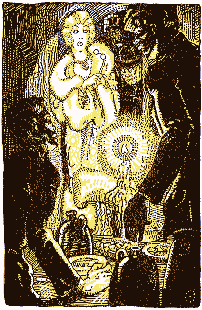 The earliest work listed in Roland Trenary's The Art of
Mahlon Blaine bibliography is The Girdle of Chastity.
It is supposed to have been published in Paris in 1923. Blaine
would have been 29. It is indicative of both Blaine's choice of
exotic and/or erotic subject matter and the misdirection of the
producers of same. I find it unlikely that a young film designer
in Hollywood would be tapped by a Parisian publisher to create
illustrations for a book on the chastity belt. And I find the
date just as suspect as the publisher, especially since nothing
else appears in the bibliography until 1926.
The earliest work listed in Roland Trenary's The Art of
Mahlon Blaine bibliography is The Girdle of Chastity.
It is supposed to have been published in Paris in 1923. Blaine
would have been 29. It is indicative of both Blaine's choice of
exotic and/or erotic subject matter and the misdirection of the
producers of same. I find it unlikely that a young film designer
in Hollywood would be tapped by a Parisian publisher to create
illustrations for a book on the chastity belt. And I find the
date just as suspect as the publisher, especially since nothing
else appears in the bibliography until 1926.
 His book career definitely begins in 1926
and I'm finally on factual solid ground. That year he produced
illustrations for Limehouse Nights - a collection of sordid
tales centered around the Oriental community of London's Limehouse
district - and a Howard Pease seafaring potboiler titled The
Tattooed Man. These two books are fairly indicative of a schizophrenic
early career. Limehouse Nights (above right) showcases
the exotic side of him while The Tattooed Man (at left)
the prosaic. A quick assessment of these two pieces shows just
where Blaine's interests lay.
His book career definitely begins in 1926
and I'm finally on factual solid ground. That year he produced
illustrations for Limehouse Nights - a collection of sordid
tales centered around the Oriental community of London's Limehouse
district - and a Howard Pease seafaring potboiler titled The
Tattooed Man. These two books are fairly indicative of a schizophrenic
early career. Limehouse Nights (above right) showcases
the exotic side of him while The Tattooed Man (at left)
the prosaic. A quick assessment of these two pieces shows just
where Blaine's interests lay.
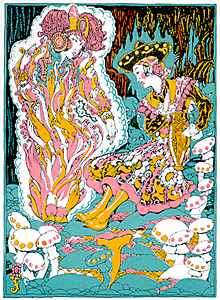 |
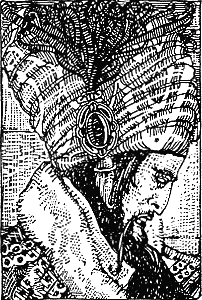
|
|
Castles in Spain and other enchantments (1928) by Bertha Gunterman |
The Golden Book (1/30) Lepanto by G.K. Chesterton |
On the one hand, his prosaic career built nicely along traditional lines. The Further Side of Silence (1927) and Bushwhacking (1929), both by Hugh Clifford, were rollicking adventure stories set in Malaysia and east Asia. Castles in Spain was a collection of Spanish legends. Black Majesty (1928) was a runaway best seller about Haiti's King Christophe. The Little Spotted Seal and The Chief of the Herd (both 1929) were children's books (the latter was the follow-up effort by Dhan Gopal Mukerji to his 1928 Newbery Award winner - Gay-Neck, the Story of a Pigeon which had been illustrated by Boris Artzybasheff!). The prestigious literary magazine, The Golden Book Magazine, featured Blaine art on a regular basis in 1930, often under covers by that same Artzybasheff, and even once as accompaniment to a poem by Lord Dunsany.
His stylistic black drawings, often highlighted and textured with crosshatches of pure white, were novel and unique. They added a visual texture to the books and magazine in which they appeared. Blaine was primarily self-taught as an artist (if we can believe him) and credited the "museums of the world" as his classrooms.
At left is a small portion of a Blaine original and you can
see how the white was used to break up the black lines. It stands
out sharply from the tanned paper. I no longer have the original
or I would have made a larger scan. Sorry.

In parallel with this commercial success was a career of a darker sort. Also successful, it was the career that received the brunt of his interest and effort. Like Aubrey Beardsley, to whom he is sometimes compared, Blaine gravitated to the edges of "respectable" literature. Flaubert's Salammbo and the demonic The Sorcerer's Apprentice by Hanns Heinz Ewers both debuted in 1927 and immediately went into second printings. That year he also did the endpapers for The Man Who Was Born Again by Paul Busson.
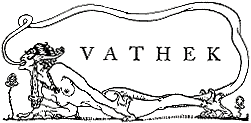 However, it was in William Beckford's Vathek
(1928) that his inner demons began streaming onto the pages. Blaine's
women could be beautiful and sensuous, but they were most often
satanic and dangerous. The tailed and clawed Harpy at left is
just a prelude to many such that would haunt his art for the rest
of his career. Then, too, Vathek is one of his best books
with lots of illustrations upon which he obviously lavished great
care.
However, it was in William Beckford's Vathek
(1928) that his inner demons began streaming onto the pages. Blaine's
women could be beautiful and sensuous, but they were most often
satanic and dangerous. The tailed and clawed Harpy at left is
just a prelude to many such that would haunt his art for the rest
of his career. Then, too, Vathek is one of his best books
with lots of illustrations upon which he obviously lavished great
care.
More debauchery followed in Alraune, the second Hanns Ewers book in 1929. And that ended his association with the publisher John Day. The Day books are generally considered among his best. And the sad truth is that most of his best work was done prior to 1935 and most of it was for the exotic market. A good example is the 1929 title page below from Hashish and Incense by Paul Verlaine.
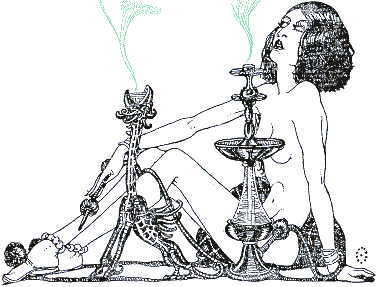
Also in 1929, Blaine published a portfolio of his work limited to 50 copies, each with an original of one of the plates. In this very private venue, all fetters were off and the tenor of the drawings, moreso than anything explicitly depicted, was disturbing. Lots of cloven-hooved women with sinuous tails in dominating situations made the portfolio, untitled but commonly known as Venus Sardonicus, as much a depiction of a psyche as of erotica. An edition of de Sade's Justine followed in 1931.
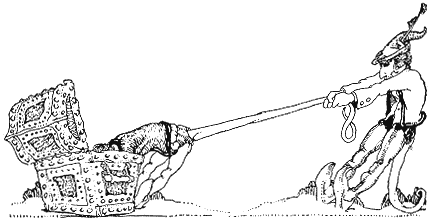
As the Depression deepened, Blaine tried to return to the more commercial children's book market. Here Comes Somebody (above, 1935) featured some energetic and complex full page plates and charming chapter heads like the one above. Apparently it wasn't what the market was looking for. In 1962 Blaine resurfaced to draw some uninspired illustrations for many of the Canaveral Press Edgar Rice Burroughs hard back editions. As an indication of how weak they are, I don't even have one title in my collection.
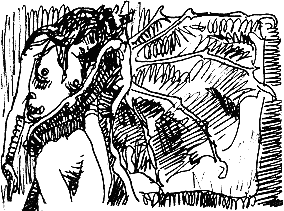 Around 1935 Blaine seems to retire from polite
society, living in the "secret publishing office - a dusty
loft in an old office building"
Around 1935 Blaine seems to retire from polite
society, living in the "secret publishing office - a dusty
loft in an old office building"![]() of a New York pornographer according to Legman.
There he produced drawings on demand for the publisher and others.
His work shows up in such 'classic' tomes as Satanism and Witchcraft
(1939) (image at right) and Loves of the Orient (1954).
In 1941, using the pseudonym G. Christopher Hudson, he illustrated
The Maniac. A Realist Study of Madness from the Maniac's Point
of View. Legman calls it his best work. I've recently acquired
a copy and, while I'm not prepared to classify it as his best,
it is most intriguing and disturbing and a perfect accompaniment
to a book written by a madwoman. One very small sample is below.
of a New York pornographer according to Legman.
There he produced drawings on demand for the publisher and others.
His work shows up in such 'classic' tomes as Satanism and Witchcraft
(1939) (image at right) and Loves of the Orient (1954).
In 1941, using the pseudonym G. Christopher Hudson, he illustrated
The Maniac. A Realist Study of Madness from the Maniac's Point
of View. Legman calls it his best work. I've recently acquired
a copy and, while I'm not prepared to classify it as his best,
it is most intriguing and disturbing and a perfect accompaniment
to a book written by a madwoman. One very small sample is below.

He also crafted artwork for patrons like Joseph Dunninger. There's even a book titled Dunninger's Magic Tricks from 1951 that is thoroughly illustrated, including a color cover, by Blaine. Gerry de la Ree's wonderful The Art of the Fantastic reproduces two Blaine pieces inscribed to Dunninger. All of this was done while living out of "hidden lofts" and scrounging food and clothing from friends.
At some point during the 1940s he is supposed to have "gone
west" to Arizona and "landed a job as art editor of
a state-subsidized magazine, Arizona Highways, which was
under his editorship during the war years and just after."![]() In the Introduction
to the same book, Robert Arrington states, "He was also supposed
to have worked for Arizona Highways in the early 1940s,
but the present editors can find no record of it."
In the Introduction
to the same book, Robert Arrington states, "He was also supposed
to have worked for Arizona Highways in the early 1940s,
but the present editors can find no record of it."![]() Arrington also states that Blaine did live
in California during the late 1950s and returned to New York in
the early 1960s.
Arrington also states that Blaine did live
in California during the late 1950s and returned to New York in
the early 1960s.
There he produced the ERB Canaveral Press illustrations while living above the bookshop of the publishers. His bohemian lifestyle was such that no one really knows when he died. The estimate is around 1970. (Thanks to Charles L. Dibble and the Social Security Death Index we can now pinpoint January of 1969 as the month and year of his death.)
 To learn more about Mahlon Blaine, see:
To learn more about Mahlon Blaine, see:
| The Art of the Fantastic | Gerry de la Ree, 1978 de la Ree |
|
|
G. Legman, 1982 Pergrine Books |
| The Vadeboncoeur Collection of Knowledge | Jim Vadeboncoeur, Jr. 2000 |
|
This page written, designed & © 2001 by Jim Vadeboncoeur, Jr. Updated 2007, 2010, 2011. |
